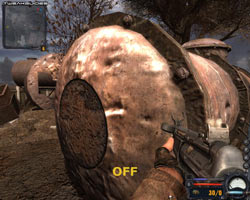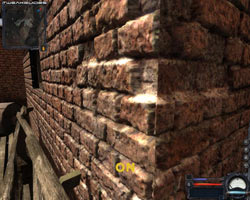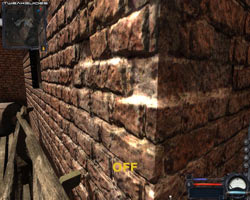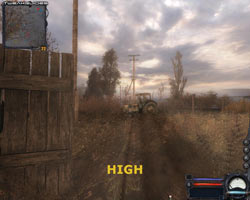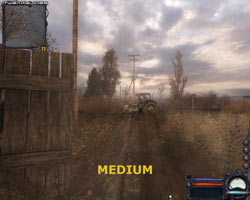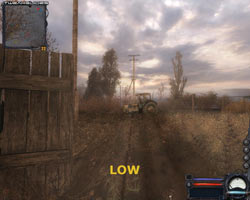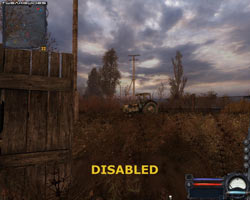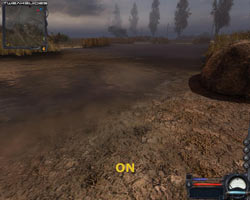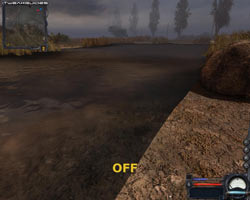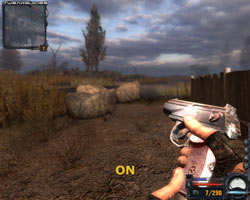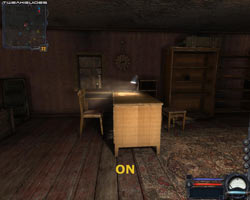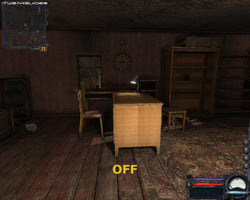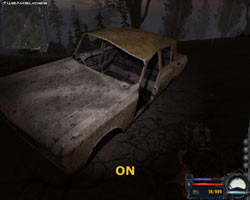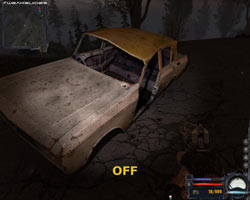STALKER: Clear Sky Tweak Guide
[Page 6] In-Game Settings (Pt.2)
Shadow Quality: This slider determines the appearance of shadows cast from dynamic lights in the game, with the higher the quality the lower your FPS. The difference between the lowest and highest setting on this slider is difficult to capture in a static screenshot - in general the difference is not major, the most noticeable effect being that low quality shadows are blockier and slightly less distinct, and tend to shimmer more as they move. Note that you can further customize shadow quality by directly choosing shadow map resolution sizes with the -smap1536, -smap2048, -smap2560, -smap3072, and -smap4096 command line switches covered in the Advanced Tweaking section.
NPC Flashlights: If this option is enabled, Non-Player Characters (NPCs - i.e. any computer-controlled characters) can use flashlights similar to the one you have. While this increases realism, in scenes with multiple flashlights and in particular with dynamic lighting enabled it also reduces FPS. If you find heavy combat scenes are becoming quite 'laggy', you may want to disable this option, but note that this also makes finding the enemy slightly harder at night or underground, since you can't track them or see them approach just by their torchlight.
Disable Detail Textures: Not available unless you use the Static Lighting render mode, this option allows you to enable or disable Detail Textures, which are an extra layer of detailing on the surfaces of some objects, only visible when examined close up. For example with this option unticked (i.e. Detail Textures enabled), looking closely at a stone wall will show very fine grain; with it disabled the wall is much smoother. Disabling Detail Textures can be useful in further improving performance on very old or slow graphics cards.
Detail Bump: This option controls the use of Bump Mapping to enhance the realism and depth on detailed surfaces such as on pitted stone rocks or metal-covered objects. As the screenshot comparison above shows, when enabled, the rusted metallic surface exhibits a lot more detailing than when it is disabled. This comes at the cost of some performance, so it can be disabled to improve FPS if needed without a major drop in realism. Note that the general appearance of surfaces is also affected by the Textures, Detail Textures, and Steep Parallax settings.
Steep Parallax: Parallax Mapping is a technique to improve bump mapped surfaces even further, making them seem deeper and more realistic. Steep Parallax mapping makes the depth of the surface even more pronounced. In Clear Sky the most noticeable impact of this setting is on brick walls, as the screenshot comparison above shows: when switched On, the bricks clearly have more depth, although this may come at a slight reduction in FPS. You must quit and reload your game for a change in this setting to come into effect.
Sun Quality: This setting controls the overall quality of sunlight in the game. In practice I found very little visual difference when altering this setting between High, Medium and Low (even with a full restart of the game between each change). However performance was noticeably better as the setting was lowered, so you may wish to lower this setting for a performance boost without any real degradation in image quality. You will need to quit and restart the game for changes in this setting to be implemented.
Update: As of the 1.5.06 patch, a new 'Ultra' option is available for the Sun Quality setting, allowing even better image quality.
Sun Rays: Only available in the new Enhanced Full Dynamic Lighting modes, this option controls the general quality of Sun Rays, also called 'God Rays' by some people. The screenshot comparison above shows the difference in image quality at High, Medium, Low and Disabled - the only truly noticeable difference is when it is Disabled, otherwise the other three settings look much the same. Performance improves noticeably however the lower you take this setting, especially during the early morning when these rays are visible and hence performance is at its slowest. This setting is very important - just setting this option to Low for example can mean the difference between unplayable and playable FPS in early morning scenes. You will need to quit and restart the game for changes in this setting to be implemented.
SSAO: SSAO is Screen Space Ambient Occlusion, a technique used to make a scene much deeper, richer and hence more realistic. In practice this means that shadowing and depth effects in particular are visually improved, although sometimes the difference can be subtle. As SSAO is increased using this setting, it can noticeably reduce performance due to the extra processing requirements on your graphics card. An animated screenshot comparison of SSAO at High vs. SSAO Disabled is provided to demonstrate the clearest difference: ClearSky_SSAO.gif (640 KB). Note in particular that with SSAO Off, the entire scene is lighter and more 'flat'; with SSAO at High, everything from the background scenery, to the ground, to the Stalker in the middle of the scene have more depth and substance. However obviously if you really need the extra performance, then lowering this setting or even disabling it altogether can be a quick way to gain FPS without totally ruining image quality. You will need to quit and restart the game for changes in this setting to be implemented.
Soft Water: This option controls whether the edges of bodies of water in Clear Sky have softly blended, realistic edges at the cost of some performance, or hard unrealistic edges. The screenshot comparison above shows the difference. You will need to quit and restart the game for changes in this setting to be implemented.
Soft Particles: Similar to the Soft Water setting above, this setting controls whether particle effects such as smoke and dust are more subtly blended with their surrounding environment, as opposed to having hard edges In practice if you find that you are getting slowdowns in foggy/smokey areas, as well as during heavy combat, you should disable this setting. You will need to quit and restart the game for changes in this setting to be implemented.
Depth of Field: If enabled, when you go to reload your weapon for example, because your focus is supposedly on your gun, the background will be slightly blurred in a custom Depth of Field effect. The screenshot above shows how this effect works, blurring the background slightly as the foreground and your weapon remain in focus. It may reduce FPS slightly when in effect, but more importantly it can also be distracting and make visibility difficult if you are trying to spot enemy positions while reloading, so you may wish to disable it for that reason. Alternatively you can customize the Depth of Field effect, even apply DoF permanently to the game, using the various r2_dof_ settings as covered in the Advanced Tweaking section. You will need to quit and restart the game for changes in this setting to be implemented.
Volumetric Light: Volumetric lighting gives light sources greater volume, making them look richer and interact more realistically with objects, casting appropriate shadow lines. The most prominent example of volumetric lighting in Clear Sky is the way sunlight streams through branches and other solid objects as 'God Rays'. However this setting doesn't actually affect those sunlight rays, they are controlled by the Sun Rays setting (see further above). Instead this setting controls the light rays from other light sources, as shown in the screenshot comparison above. When disabled it can improve performance in areas with light sources. You will need to quit and restart the game for changes in this setting to be implemented.
Wet Surfaces: When enabled, this effect greatly increases the realism of wet surfaces, at the cost of a slight drop in performance. As the screenshot comparison above shows, during rain, when enabled, water covers the car body with a slick sheen that runs down the right side, and displays raindrop splashes on the hood; when disabled the car has no real sign of water coverage. This effect really does make a noticeable difference during rain, covering all manner of surfaces with realistic water flows and shine, and is generally worth the minimal drop in performance. Note that you can customize the way this effect looks using the r3_dynamic_wet_surfaces settings as detailed in the Advanced Tweaking section. You will need to quit and restart the game for changes in this setting to be implemented.
Volumetric Smoke: This effect, when turned on, allows smoke to flow more realistically, and react dynamically with the environment. For example a fan blowing through smoke makes the smoke go through realistic patterns of movement. It is difficult to capture in a screenshot, so see this YouTube Video to better examine how it works. Enabling this option comes at the cost of performance loss in areas where smoke is visible, so if you notice severe slowdowns in smoke or fog-filled areas, turn this setting off. You will need to quit and restart the game for changes in this setting to be implemented.
Update: The following two settings were added as of the 1.5.06 Patch:
Antialias A-tested Objects: This option can only be accessed in DX10 mode when the Antialiasing option (see previous page) has been set to anything other than disabled. When Multisampling Antialiasing (MSAA) is being used, this option allows you to enable and use either DirectX 10 or DirectX 10.1 style MSAA on alpha-tested objects (i.e. objects with transparent portions, such as foliage). This can help to greatly reduce the jagged appearance of Clear Sky's environment by smoothing grass and trees, however it comes at an additional performance cost. If your graphics card is capable of DX10.1, then this is the recommended mode as it should improve performance and image quality as well when using this option.
Use DX10.1: If your graphics card supports DirectX 10.1, then you can enable this option, which should help to improve performance when in DX10 mode. If available to you, I recommend testing to see the impact of this option, though remember that a restart is required to implement it properly.
Vertical Sync: Video Synchronization (VSync) is the synchronization of your graphics card and monitors' abilities to redraw an image on the screen a number of times each second, measured in Hz. It is explained in plain English on this page of my Gamer's Graphics & Display Settings Guide. When VSync is enabled your maximum FPS will be capped at your monitor's maximum refresh rate at your chosen resolution, and more importantly in some areas your FPS may drop by as much as 50% if the graphics card has to wait to display a whole frame. Furthermore enabling VSync can increase feelings of 'mouse lag'. You can counter the FPS drop of VSync by enabling Triple Buffering, but this can cause additional mouse lag as well. On balance I recommend leaving VSync disabled.
Frequency 60Hz: If disabled, this option allows your Refresh Rate to exceed 60Hz. If you run a CRT monitor then you can disable this option, as most CRT monitors can easily exceed a 60Hz refresh rate which can both help to improve FPS if VSync is enabled, and reduce eye strain as well. If you run an LCD monitor however, it can remain lit - in practice it makes little difference for LCD monitors; see the link above to understand why.
Sound
SFX, Music Volume: These sliders control the volume level of the Special Effects (SFX), and any Music in game, such as that played in the main menu. Setting these sliders to the far left does not turn remove music or sound effects, so it has no impact on performance. See the Advanced Tweaking section if you wish to actually disable the loading of all sounds, e.g. to troubleshoot a sound problem.
EAX: You can enable Environmental Audio (EAX) on sound cards which support this functionality - it appears to be EAX 2.0, which most sound devices will support. When enabled, sound effects will become more realistic in 3D space, but it may also reduce performance slightly and can cause audio glitches on some systems.
Dynamic Music: If switched on, the game will automatically switch to more 'dynamic' music style whenever dramatic things occur, such as when you are in combat. In my opinion the dynamic music is not particularly good or suitable, however it is up to personal taste as to whether you enable it; the performance impact is negligible.
Sound Device: This option determines the sound renderer that Clear Sky will use. The usual options include Generic Software, Generic Hardware and your specific sound device. Generally speaking it is better to select your actual sound hardware as that provides the best quality audio, and the performance impact should not be great. In practice however some sound devices may exhibit glitches or cause other problems, including crashes, so you may have to revert back to Generic Software if this is the case.
If you are having audio problems, first make sure you're running the latest audio driver for your sound solution. Then you may want to try switching the audio renderer under the Sound Device box, either to see if performance and/or functionality improves, or to see if it resolves your audio problems. If that doesn't work, for further troubleshooting first make sure your OpenAL version is the latest by checking here - download and compare the file versions of the existing OpenAL32.dll and wrap_oal.dll files under your \Program Files\Deep Silver\S.T.A.L.K.E.R. - Clear Sky directory. Finally, you can experiment with the snd_ variables, as well as the -nosound switch, covered in the Advanced Tweaking section to see if sound is the source of the problem. If nothing else works, then either a new patch from the game's developers, or new audio drivers, or both, may be required.
Note that unlike Shadow of Chernobyl, Clear Sky doesn't seem to have a DirectSound capability; the -dsound switch no longer works. Clear Sky runs on OpenAL audio, which also means that full hardware acceleration is possible under Vista without requiring something like Creative's ALchemy.
Game
Difficulty: You can select from four different difficulty levels in the drop box here. In order of easiest to hardest these are: Novice, Stalker, Veteran and Master. The higher the setting, the fewer useful objects can be found in the game world, and the greater the probability that the enemy will hit you when firing on you. For example at Novice level, the enemy only have a 20% chance of hitting you, while at Master they have a 50% chance of hitting you with each shot. You can also adjust the difficulty on the fly, so if you find a particular area too hard then turn down the difficulty temporarily.
Show Crosshair: If enabled, shows a crosshair on the screen. This is recommended as it obviously makes aiming weapons much easier. You may wish to turn off the crosshair when taking screenshots however.
Dynamic Crosshair: If enabled, the crosshair will change shape depending on the weapon you currently have equipped and your movements. For example using a shotgun will provide a wider crosshair, since the shotgun has a wider spread. If you're moving around, dynamic crosshairs will also resize to represent reduced accuracy. In general you should only disable this if you find it to be a distraction.
Show Weapon: If enabled, your currently equipped weapon is shown in front of you on the screen. Disabling this option will remove the displayed weapon, which can help improve FPS and visibility, but may also cause confusion if you momentarily forget which weapon you have currently equipped.
Crosshair Target Distance: If enabled, the distance in meters to the object highlighted under your crosshair will be shown in the crosshair. If you find this annoying or unrealistic, disable the option here.
NPC Identification: If enabled, the NPC currently under your crosshair will be identified, including whether they are friendly (green), neutral (yellow) or hostile (red), their name, and the faction to which they belong. While generally best kept enabled, especially at the start of the game, you may wish to disable this for greater realism or to increase difficulty.
Controls
Mouse Sensitivity: This slider determines how sensitive your in-game movements will be to your mouse movements. Set to suit your taste as it has no impact on performance. Keep in mind that any 'laggy' feel or lack of responsiveness you experience from the mouse in the game is primarily due to low framerates. Aside from adjusting the various graphics settings to improve your average framerate, also try disabling Vertical Sync and Triple Buffering, as well as changing your Render mode to a lower one.
Invert Mouse: If enabled, pushing your mouse forward will make your character look down, and pulling your mouse back will make him look up. If disabled, the opposite will occur. Set to suit your taste, has no impact on performance.
The remainder of the controls here are fairly self-explanatory and can be set to suit your particular preferences. Note that you can change your key configuration, and bind both documented and undocumented actions by firstly using the bind_list command to see all bindable actions, and then using the bind command either in the Command Console, or in your User.ltx file. For example to bind the jump function to the J key, type bind jump kJ in the console, or edit the appropriate line in User.ltx. See the Advanced Tweaking section for details.
Whenever you change any of the in-game settings, click the Use button at any time to put them into effect. Note again that many settings require that you quit and restart the game for them to be implemented properly, even though this is often not noted by the game after you've changed the setting. To be absolutely certain that your settings are correctly implemented, always quit and restart after applying any changes.
The next page starts our look at STALKER: Clear Sky's many Advanced Tweaking opportunities.


